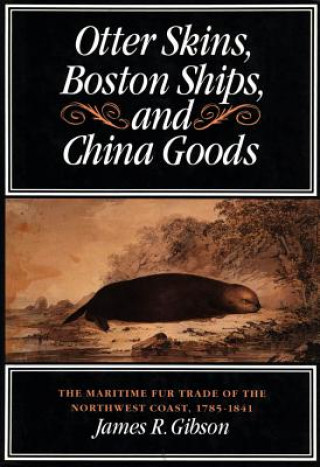
Code: 04917087
Otter Skins, Boston Ships, and China Goods
by James R. Gibson
Before contact with white people, the Northwest Coast natives had traded amongst themselves and with other indigenous people farther inland. By the end of the 1780s, when Russian coasters had penetrated the Gulf of Alaska and Brit ... more
- Language:
 English
English - Binding: Hardback
- Number of pages: 448
Publisher: McGill-Queen's University Press, 1992
- More about this

137.43 €
Availability:
50/50 We think title might be available. Upon your order we will do our best to get it within 6 weeks.
We think title might be available. Upon your order we will do our best to get it within 6 weeks.We search the world
You might also like
-

Texture of Contact
49.60 € -19 %
Give this book as a present today
- Order book and choose Gift Order.
- We will send you book gift voucher at once. You can give it out to anyone.
- Book will be send to donee, nothing more to care about.
Availability alert
Enter your e-mail address and once book will be available,
we will send you a message. It's that simple.
More about Otter Skins, Boston Ships, and China Goods
You get 339 loyalty points
 Book synopsis
Book synopsis
Before contact with white people, the Northwest Coast natives had traded amongst themselves and with other indigenous people farther inland. By the end of the 1780s, when Russian coasters had penetrated the Gulf of Alaska and British merchantmen were frequenting Nootka Sound, trade had become the dominant economic activity in the area. The Northwest Coast Indians spent much of their time hunting fur-bearing animals and trading their pelts - especially the highly prized 'black skins' of sea otters - to Russian, British, Spanish, and American traders for metals, firearms, textiles, and foodstuffs. They used their newly acquired goods in intertribal trade while the Euro-American traders dealt their skins in China for teas, silks, and porcelains that they then sold in Europe and America. This traffic continued for more than half a century until, in the early 1840s, the Northwest trade declined significantly because of depletion of the fur-bearing animals due to over-hunting, depopulation of the Indians by disease and warfare, and depression of the market for furs. While previous studies have concentrated on the boom years of the fur trade before the War of 1812, Gibson reveals that the maritime fur trade persisted into the 1840s and shows that the trade was not solely or even principally the domain of American traders. He gives an account of Russian, British, Spanish, and American participation in the Northwest traffic, describes the market in South China, and outlines the evolution of the coast trade, including the means and problems. He also assesses the physical and cultural effects of this trade on the Northwest Coast and Hawaiian Islands and on the industrialisation of the New England states. Gibson's new interpretations derive in part from his use of Western primary sources that have been largely ignored by previous investigators. In addition to being the first to use many Russian-language sources, Gibson consulted the records of the Russian-American, East India, and Hudson's Bay Companies, the unpublished logs and journals of a number of American ships, and the business correspondence of several New England shipowners. No more comprehensive or painstakingly researched account of the maritime fur trade of the Northwest Coast has ever been written. James R. Gibson is a professor in the Department of Geography, York University.
 Book details
Book details
Book category Knihy po anglicky Humanities History History: specific events & topics
137.43 €
- Full title: Otter Skins, Boston Ships, and China Goods
- Subtitle: The Maritime Fur Trade of the Northwest Coast, 1785-1841
- Author: James R. Gibson
- Language:
 English
English - Binding: Hardback
- Number of pages: 448
- EAN: 9780773508293
- ID: 04917087
- Publisher: McGill-Queen's University Press
- Weight: 802 g
- Date of publishing: 14. January 1992
Trending among others
-

Man's Search for Meaning
7.28 € -5 % -

Ascent of Money
17.86 € -14 % -

Mein Kampf - The Ford Translation
35.94 € -12 % -

Women's Work
19.61 € -15 % -

Corgi Toys
14.68 € -20 % -

Around the World Submerged
39.54 € -

Queer Little History of Art
16.22 € -25 % -

Perfect Storm
13.14 € -18 % -

Women, Race & Class
9.95 € -24 % -

Holocaust Industry
11.70 € -19 % -

Scouting for Boys
10.47 € -28 % -

The Complete MAUS
18.68 € -14 % -

Man's Search For Meaning
15.60 € -28 % -

Ordinary Men
10.26 € -29 % -

The Rape of Nanking
15.91 € -24 % -

Conquerors
12.83 € -14 % -

Secret Lives of Colour
14.06 € -29 % -

Monk
9.34 € -29 % -

White Gold
13.55 € -28 % -

Homo Deus
12.42 € -27 % -

Eichmann in Jerusalem
10.98 € -24 % -

Bloodlands
12.83 € -24 % -

Delirious New York
29.98 € -17 % -

East West Street
10.16 € -25 % -

Brief History of Japan
12.93 € -25 % -

Diary of a Young Girl
9.54 € -

Twelve Years a Slave
3.58 € -24 % -

More Money Than God
18.58 € -17 % -

Eichmann in Jerusalem
13.75 € -29 % -

Mein Kampf
27.31 € -12 % -

Square and the Tower
14.06 € -29 % -

My Mad Fat Diary
11.49 € -28 % -

Discourse on Colonialism
11.70 € -19 % -

Empires of the Sea
14.37 € -23 % -

If This Is A Man/The Truce
14.37 € -23 % -

Origins of Museums
53.61 € -24 % -

Golden Atlas
25.67 € -28 % -

1960s Scrapbook
17.76 € -17 % -

Diary of a Young Girl
10.06 € -26 % -

Auschwitz Volunteer
39.74 € -

Night
11.08 € -24 % -

Victorian House
17.55 € -28 % -

London Labour and the London Poor
5.84 € -22 % -

This Way for the Gas, Ladies and Gentlemen
10.88 € -43 % -

Bitten By Witch Fever
38.41 € -10 % -

Influence of Sea Power Upon History, 1660-1783
23.72 € -24 % -

Story of Esci
27.42 € -

Scouting for Boys
19.71 € -20 % -

Titanic and Other Ships
14.68 €
Osobný odber Bratislava a 2642 dalších
Copyright ©2008-24 najlacnejsie-knihy.sk Všetky práva vyhradenéSúkromieCookies


 21 miliónov titulov
21 miliónov titulov Vrátenie do mesiaca
Vrátenie do mesiaca 02/210 210 99 (8-15.30h)
02/210 210 99 (8-15.30h)